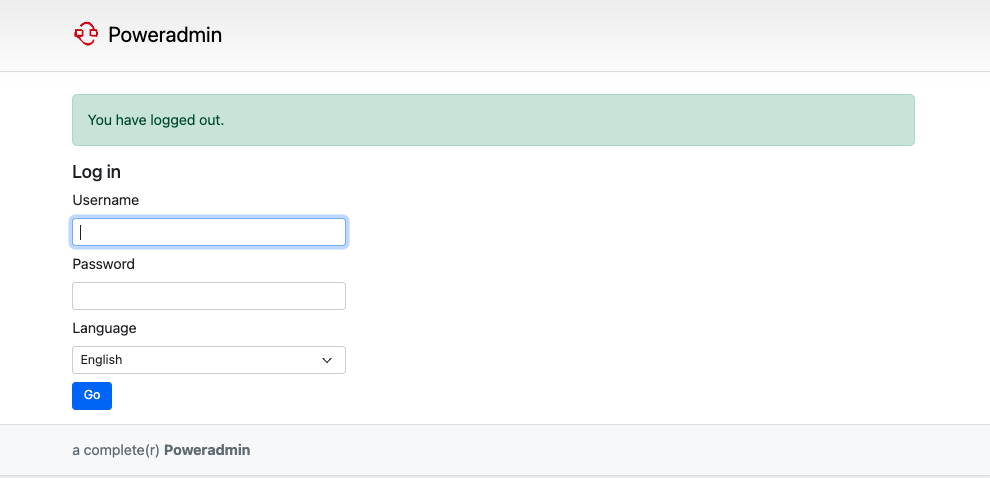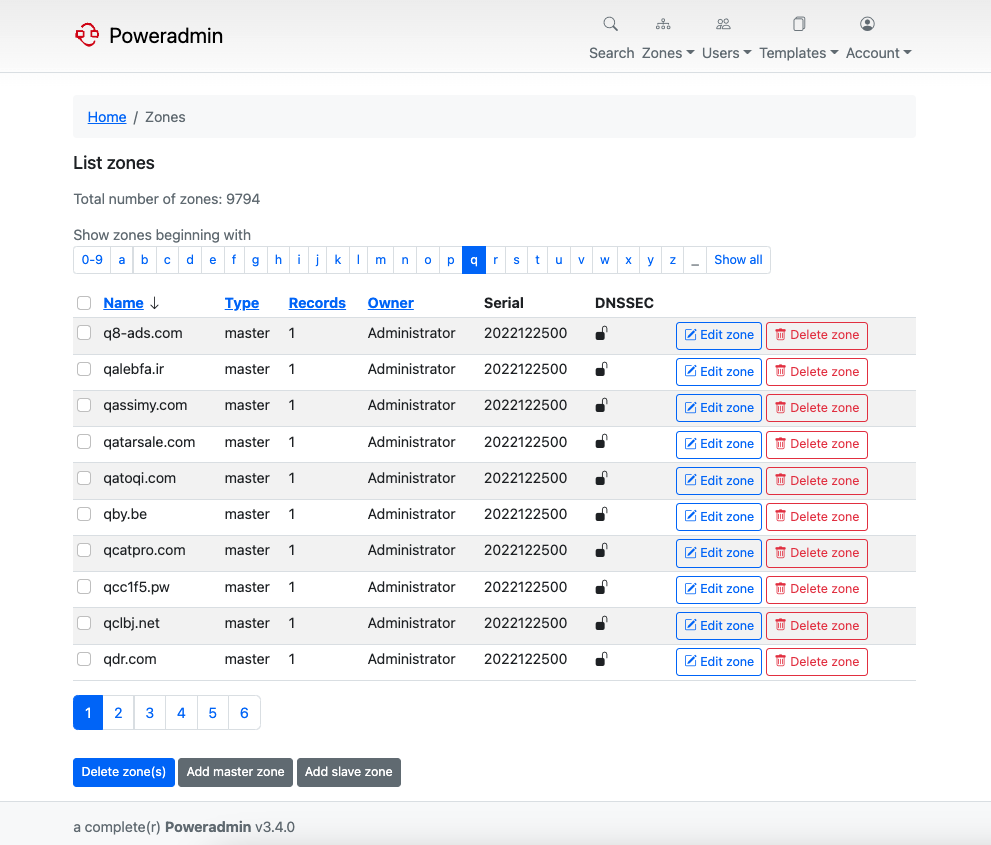Poweradmin is a friendly web-based DNS administration tool for PowerDNS server. The interface supports most of the features of PowerDNS. It is a hybrid solution that uses SQL for most operations and has PowerDNS support for DNSSEC operations.
- Supports all zone types (master, native, and slave)
- Supermasters for automatic provisioning of slave zones
- IPv6 support
- Multi-language support
- DNSSEC operations
- Light and dark themes
- Ability to add reverse records
- LDAP authentication support with custom filter
This project is not associated with PowerDNS.com , Open-Xchange, or any other external parties. It is independently funded and maintained. If this project does not fulfill your requirements, please explore these alternative options.
This project is licensed under the GNU General Public License v3.0. See the LICENSE file for more details.
- PHP 8.1 or higher (including 8.2, 8.3, 8.4, etc.)
- PHP intl extension
- PHP gettext extension
- PHP openssl extension
- PHP filter extension
- PHP tokenizer extension
- PHP pdo extension
- PHP pdo-mysql, pdo-pgsql or pdo-sqlite extension
- PHP ldap extension (optional)
- MySQL 5.7.x/8.x, MariaDB, PostgreSQL or SQLite database
- PowerDNS authoritative server 4.0.0+
| Poweradmin | PHP | PowerDNS | MariaDB | MySQL | PostgreSQL | SQLite |
|---|---|---|---|---|---|---|
| 3.9.x | 8.1.30 | 4.5.5 | 10.11.9 | - | 16.3 | 3.45.3 |
| 3.8.x | 8.1.28 | 4.5.5 | 10.11.8 | - | 16.3 | 3.45.3 |
| 3.7.x | 8.1.2 | 4.5.3 | 11.1.2 | 8.2.0 | 16.0 | 3.40.1 |
| 3.6.x | 8.1.2 | 4.5.3 | 11.1.2 | 8.1.0 | 16.0 | 3.40.1 |
| 3.5.x | 8.1.17 | 4.5.3 | 10.11.2 | 8.0.32 | 15.2 | 3.34.1 |
| 3.4.x | 7.4.3 / 8.1.12 | 4.2.1 | 10.10.2 | 8.0.31 | 15.1 | 3.34.1 |
Install the following dependencies:
On Debian-based systems and their derivatives:
apt install php-intl php-gettext php-openssl php-filter php-tokenizer php-pdo
For MySQL/MariaDB
apt install php-mysqlnd
For PostgreSQL
apt install php-pgsql
For SQLite
apt install php-sqlite3On Red Hat Enterprise Linux (RHEL) and its derivatives:
dnf install -y php-intl php-gettext php-openssl php-filter php-tokenizer php-pdo
For MySQL/MariaDB
dnf install -y php-mysqlnd
For PostgreSQL
dnf install -y php-pgsqlDownload the project files
- Via Git:
- Clone the repository:
git clone https://github.com/poweradmin/poweradmin.git - Select latest tag (for example v3.8.0) or skip this if you want to run from master:
git checkout tags/v3.8.0
- Clone the repository:
- Via releases:
- Get the latest file from releases
Go to the installed system in your browser
- Visit http(s)://URL/install/ and follow the installation steps.
- Once the installation is complete, remove the
installfolder. - Point your browser to: http(s)://URL
- Log in using the default 'admin' username and the password created during setup (provided in step 3).
To help diagnose issues, you can enable various debug settings in the inc/config.inc.php file. Below are the available
debug settings and how to enable them:
-
PHP Error Reporting: To display PHP errors directly in the browser, add the following lines to your
index.phpor any other entry point file:ini_set('display_errors', 1); ini_set('display_startup_errors', 1); error_reporting(E_ALL);
-
Logger Settings: Configure the logging settings to use the native type and debug level. Currently, these settings are used only for logging authentication issues:
$logger_type = 'native'; $logger_level = 'debug';
-
Database Debugging: Enable or disable database debugging. When enabled, detailed database operations and errors will be logged:
$db_debug = true;
-
DNSSEC Debugging: Enable or disable DNSSEC debugging. When enabled, detailed DNSSEC operations and errors will be logged:
$pdnssec_debug = true;
-
LDAP Debugging: Enable or disable LDAP debugging. When enabled, detailed LDAP operations and errors will be logged:
$ldap_debug = true;
By enabling these settings, you can gain more insight into the application's behavior and troubleshoot issues more effectively.
- Fork the Repository: Use the "Fork" button on the repository page to create a copy of the repository under your GitHub account.
- Clone the Forked Repository: Download the forked repository to your local machine.
- Create a New Branch: Create a new branch for your feature or bugfix.
- Make Changes: Make your changes to the codebase.
- Commit Changes: Save your changes with a descriptive commit message.
- Push Changes: Upload your changes to your forked repository.
- Create a Pull Request: Go to the original repository and create a pull request from your forked repository.
Please note that while I am open to contributions, I might only take the good parts of your submission or rewrite it to keep in sync with the overall style and structure of the project. However, I will still keep a reference to you as the original contributor. This will be mentioned in the release notes.
All contributions will be reviewed. Feedback will be provided, and you may be asked to make additional changes.
Ensure that your changes are well-tested.
Thank you for your contributions!

